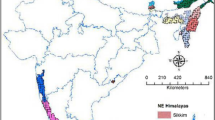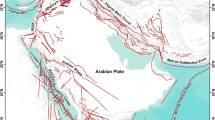Abstract
Uttarakhand, a state located in the seismically active western Himalayas (India), has witnessed several high magnitude earthquakes in the past. It falls under zones IV (severe) and V (very severe) as per the seismic code of India. The region has several major hydroelectric and infrastructural projects that are presently operational and in the planning stages. Therefore, it is necessary to determine the area expected to be affected by the seismic activity in this region. The seismic hazard assessment of the study area was conducted using the Cornell–McGuire approach. A comprehensive earthquake catalog was prepared considering all the earthquakes occurrences within a 300-km radius of the study area. The catalog was declustered and homogenized into a single-moment magnitude scale considering different region-specific conversion relationships. The study area was divided into ten discrete seismogenic source zones. These source zones were modeled as separate area sources. For each of these zones, seismicity parameters were evaluated using the earthquake catalog and tectonic framework. The hazard assessment at the bedrock level was carried out by combining regional and global attenuation models in a logic tree architecture. The seismic hazard at the surface level was evaluated based on suitable site amplification factors determined for different site classes using shear velocity in the top 30 m (VS30) obtained from the topographic gradient. The results were presented in terms of Arias intensity and peak ground acceleration (PGA) hazard maps for 2% and 10% probability of exceedance in 50 years. The analysis observed that 80 % of the study area is highly vulnerable to seismic hazards, including landslides/rockslides. The predicted ground motion intensity in this study will aid in the safe design of structures and the proper planning of important infrastructure projects.









Similar content being viewed by others
References
Allen TI, Wald DJ (2009) On the use of high-resolution topographic data as a proxy for seismic site conditions (VS30). Bull Seismol Soc Am 99:935–943. https://doi.org/10.1785/0120080255
Amante C, Eakins BW (2009) ETOPO1 1 arc-minute global relief model: procedures, data sources and analysis. NOAA Technical Memorandum NESDIS NGDC-24, National Geophysical Data Center, NOAA, [01/10/2021]
Anthiraikili JB, Das HH (2021) Site classification and correlation study of HVSR curve with seismic and aquifer parameters of strong-motion sites in Uttarakhand, India. Arab J Geosci 14:1–13. https://doi.org/10.1007/s12517-021-08046-7
Arias A (1970) Measure of Earthquake Intensity. In: Hansen RJ (ed) Seismic design for nuclear power plants. Mass Massachusetts Inst of Tech Press, Cambridge, pp 438–483
Bilham R (2009) The seismic future of cities. Bull Earthq Eng 7:839–887. https://doi.org/10.1007/s10518-009-9147-0
Bommer JJ (2005) On the use of logic trees for ground-motion prediction equations in seismic-hazard analysis. Bull Seismol Soc Am 95:377–389. https://doi.org/10.1785/0120040073
Borcherdt RD, Gibbs JF (1976) Effects of local geological conditions in the San Francisco Bay region on ground motions and the intensities of the 1906 earthquake. Bull Seismol Soc Am 66:467–500. https://doi.org/10.1785/BSSA0660020467
Campbell KW, Bozorgnia Y (2014) NGA-West2 ground motion model for the average horizontal components of PGA, PGV, and 5% Damped Linear Acceleration Response Spectra. Earthquake Spectra 30:1087–1115. https://doi.org/10.1193/062913EQS175M
Cornell CA (1968) Engineering seismic risk analysis. Bull Seismol Soc Am 58:1583–1606. https://doi.org/10.1785/bssa0580051583
Das R, Wason HR, Sharma ML (2012) Temporal and spatial variations in the magnitude of completeness for homogenized moment magnitude catalogue for northeast India. J Earth Syst Sci 121:19–28. https://doi.org/10.1007/s12040-012-0144-3
Dhanya J, Gade M, Raghukanth STG (2017) Ground motion estimation during 25th April 2015 Nepal earthquake. Acta Geod Geophys 52:69–93. https://doi.org/10.1007/s40328-016-0170-8
Foulser-Piggott R, Stafford PJ (2012) A predictive model for Arias intensity at multiple sites and consideration of spatial correlations. Earthq Eng Struct Dyn 41:431–451. https://doi.org/10.1002/eqe.1137
Gardner JK, Knopoff L (1974) Is the sequence of earthquakes in Southern California, with aftershocks removed, Poissonian? Bull Seismol Soc Am 64:1363–1367. https://doi.org/10.1785/BSSA0640051363
Harp EL, Wilson RC (1995) Shaking intensity thresholds for rock falls and slides: evidence from 1987 Whittier Narrows and Superstition Hills earthquake strong motion record. Bull Seismol Soc Am 85:1739–1757. https://doi.org/10.1785/BSSA0850061739
IS:1893 (2002) Criteria for earthquake resistant design of structures - general provisions and buildings Part-1. Bur Indian Stand New Delhi Part 1:1–39
Jibson RW (1987) Summary of research on the effects of topographic amplification of earthquake shaking on slope stability. US Geol Surv reports 87–268. https://doi.org/10.3133/ofr87268
Joshi A, Kumar A, Castanos H, Lomnitz C (2013) Seismic hazard of the Uttarakhand Himalaya, India, from deterministic modeling of possible rupture planes in the area. Int J Geophys. https://doi.org/10.1155/2013/825276
Kaveh A, Bakhshpoori T, Hamze-Ziabari SM (2016) Derivation of new equations for prediction of principal ground-motion parameters using M5′ algorithm. J Earthq Eng 20:910–930. https://doi.org/10.1080/13632469.2015.1104758
Kijko A (2004) Estimation of the maximum earthquake magnitude, m max. Pure Appl Geophys 161:1655–1681. https://doi.org/10.1007/s00024-004-2531-4
Kumar P, Kumar A, Sinvhal A (2011) Assessment of seismic hazard in Uttarakhand Himalaya. Disaster Prev Manag 20:531–542. https://doi.org/10.1108/09653561111178961
Ma J, Dong L, Zhao G, Li X (2019a) Ground motions induced by mining seismic events with different focal mechanisms. Int J Rock Mech Min Sci 116:99–110. https://doi.org/10.1016/j.ijrmms.2019.03.009
Ma J, Dong L, Zhao G, Li X (2019b) Qualitative method and case study for ground vibration of tunnels induced by fault-slip in underground mine. Rock Mech Rock Eng 52:1887–1901. https://doi.org/10.1007/s00603-018-1631-x
National Disaster Management Authority (NDMA) (2011) Development of probabilistic seismic hazard map of India. Govt. of India, New Delhi
Ordaz M, Salgado-Gálvez MA (2020) R-CRISIS v20 Validation and verification document. ERN Technical Report, Mexico City
Putti SP, Satyam N (2017) Seismic hazard assessment of Vishakhapatnam-probabilistic approach. In: Indian Geotechnical Conference 2017 GeoNEst, 14-16 December 2017. IIT Guwahati, India
Putti SP, Satyam N (2018) Ground response analysis and liquefaction hazard assessment for Vishakhapatnam city. Innov Infrastruct Solut 3:12. https://doi.org/10.1007/s41062-017-0113-4
Putti SP, Satyam N (2020) Evaluation of site effects using HVSR microtremor measurements in Vishakhapatnam (India). Earth Syst Environ 4:439–454. https://doi.org/10.1007/s41748-020-00158-6
Putti SP, Devarakonda NS, Towhata I (2019) Estimation of ground response and local site effects for Vishakhapatnam, India. Nat Hazards 97:555–578. https://doi.org/10.1007/s11069-019-03658-5
Raghukanth STG, Iyengar RN (2007) Estimation of seismic spectral acceleration in Peninsular India. J Earth Syst Sci 116:199–214. https://doi.org/10.1007/s12040-007-0020-8
Rajendran K, Parameswaran RM, Rajendran CP (2017) Seismotectonic perspectives on the Himalayan arc and contiguous areas: inferences from past and recent earthquakes. Earth-Sci Rev 173:1–30. https://doi.org/10.1016/j.earscirev.2017.08.003
Ristau J (2005) Moment magnitude-local magnitude calibration for earthquakes in Western Canada. Bull Seismol Soc Am 95:1994–2000. https://doi.org/10.1785/0120050028
Rout MM, Das J, Kamal (2018) Probabilistic seismic hazard for Himalayan region using kernel estimation method (zone-free method). Nat Hazards 93:967–985. https://doi.org/10.1007/s11069-018-3336-6
Satyam N (2006) Seismic microzonation studies for Delhi region. Dissertation, Indian Institute of Technology Delhi
Satyam N, Ramancharla PKR (2010) Dynamic analysis of transmission towers under strong ground motion. In: 3rd International Earthquake Symposium, 5-6 March 2010. Dhaka
Schiffman C, Bali BS, Szeliga W, Bilham R (2013) Seismic slip deficit in the Kashmir Himalaya from GPS observations. Geophys Res Lett 40:5642–5645. https://doi.org/10.1002/2013GL057700
Shanker D (2018) On the seismic hazard in Himachal Pradesh and Uttarakhand States. Geosciences 8:21–31. https://doi.org/10.5923/j.geo.20180802.01
Singh SK, Srinagesh D, Srinivas D et al (2017) Strong ground motion in the Indo-Gangetic Plains during the 2015 Gorkha, Nepal, earthquake sequence and its prediction during future earthquakes. Bull Seismol Soc Am 107:1293–1306. https://doi.org/10.1785/0120160222
Soni K, Shanker D, Shubham SN (2019) Estimation of seismic hazard parameters for Uttarakhand region. J Rock Mech Tunn Technol 25:21–32
Stepp JC, Wong I, Whitney J et al (2001) Probabilistic seismic hazard analyses for ground motions and fault displacement at Yucca Mountain, Nevada. Earthquake Spectra 17:113–151. https://doi.org/10.1193/1.1586169
Travasarou T, Bray JD, Abrahamson NA (2003) Empirical attenuation relationship for Arias intensity. Earthq Eng Struct Dyn 32:1133–1155. https://doi.org/10.1002/eqe.270
Valdiya KS (1988) Tectonics and evolution of the central sector of the Himalaya. Philos Trans R Soc London Ser A, Math Phys Sci 326:151–175. https://doi.org/10.1098/rsta.1988.0083
Wang X, Cai M (2017) Numerical analysis of ground motion in a South African mine using SPECFEM3D. In: In: Proceedings of the First International Conference on Underground Mining Technology. Australian Centre for Geomechanics, Perth, pp 255–268
Wason HR, Das R, Sharma ML (2012) Magnitude conversion problem using general orthogonal regression. Geophys J Int 190:1091–1096. https://doi.org/10.1111/j.1365-246X.2012.05520.x
Wells DL, Coppersmith KJ (1994) New empirical relationships among magnitude, rupture length, rupture width, rupture area, and surface displacement. Bull Seismol Soc Am 84:974–1002. https://doi.org/10.1785/BSSA0840040974
Wiemer S (2001) A software package to analyze seismicity: ZMAP. Seismol Res Lett 72:373–382. https://doi.org/10.1785/gssrl.72.3.373
Wilson DK, Keefer RC (1985) Predicting areal limits of earthquake-induced landsliding. In: Ziony JI (ed) Earthquake hazards in the Los Angeles region - an earth-science perspective. U.S. Geological Survey Professional Paper, pp 316–345
Funding
This research was financially supported by the Department of Science and Technology, India, under response project number NGP/LS/TPN-34229/2019.
Author information
Authors and Affiliations
Corresponding author
Ethics declarations
Competing interests
The authors declare no competing interests.
Additional information
Responsible Editor: Longjun Dong
Rights and permissions
About this article
Cite this article
Gupta, K., Satyam, N. Estimation of Arias intensity and peak ground acceleration (PGA) using probabilistic seismic hazard assessment of Uttarakhand state (India). Arab J Geosci 15, 437 (2022). https://doi.org/10.1007/s12517-022-09733-9
Received:
Accepted:
Published:
DOI: https://doi.org/10.1007/s12517-022-09733-9




